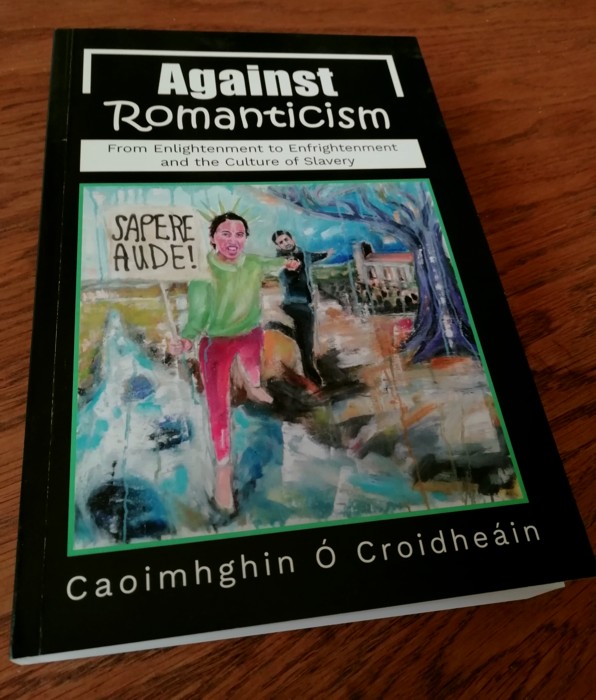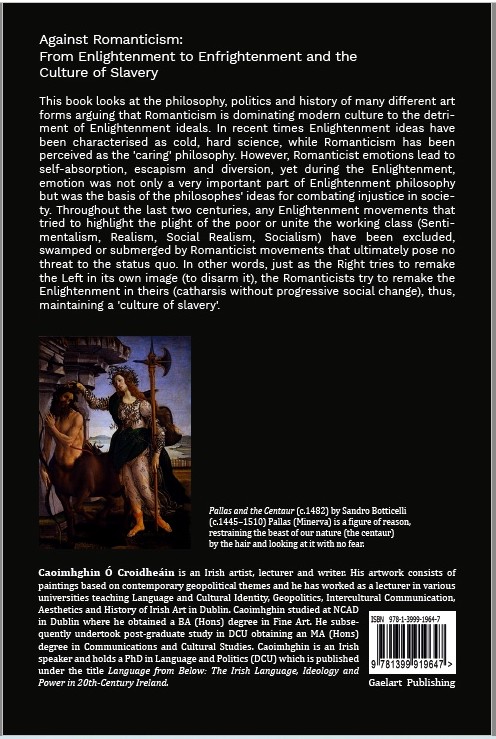|
Against Romanticism: From Enlightenment to Enfrightenment and the Culture of
Slavery
by Caoimhghin ” CroidheŠin
This book looks at the philosophy, politics and history of many different art
forms arguing that Romanticism is dominating modern culture to the detriment of
Enlightenment ideals. In recent times Enlightenment ideas have been
characterised as cold, hard science, while Romanticism has been perceived as the
'caring' philosophy.
However, Romanticist emotions lead to
self-absorption, escapism and diversion, yet during the Enlightenment, emotion
was not only a very important part of Enlightenment philosophy but was the basis
of the philosophes' ideas for combating injustice in society. Throughout the
last two centuries, any Enlightenment movements that tried to highlight the
plight of the poor or unite the working class (Sentimentalism, Realism, Social
Realism, Socialism) have been excluded, swamped or submerged by Romanticist
movements that ultimately pose no threat to the status quo.
.
Kindle version now available on:
amazon.com /
amazon.co.uk
In other words, just as the Right tries to
remake the Left in its own image (to disarm it), the Romanticists try to remake
the Enlightenment in theirs (catharsis without progressive social change), thus,
maintaining a 'culture of slavery'.
Through developing an awareness
of the socio-political fault lines in today’s culture, cultural practitioners
can create a new democratic spirit (a ‘culture of resistance’) emphasising the value of ordinary
people, while at the same time making an important contribution to the fight
against poverty, oppression, and injustice.


Back cover image:
Pallas and the Centaur (c.1482) by Sandro Botticelli
(c.1445–1510). Pallas (Minerva) is a figure of reason,
restraining the beast of our nature (the centaur)
by the hair and looking at it with no fear.
Gaelart Publishing
ISBN: 978-1-3999-1964-7
Design: Ieva Grbacjana (https://igrbacjana.com/)
Cover photography: Philip O’Neill (https://www.philiponeillphotography.com/)
Cover painting: Sapere Aude! by Caoimhghin ” CroidheŠin (http://gaelart.net/)
Back cover: Pallas and the Centaur (Public domain / Wikimedia Commons)
Printer: Paceprint (https://paceprint.ie/)
Typeset in 12pt Cambria and 10pt Work Sans
Size: 6" x 9"
Pages: 357
Weight: 750g
Material Cover: 350gsm Silk
Printing Text: 4 process colours throughout
Material Text: 90gsm Silk
Printed in Dublin in paperback only.
Publisher: Gaelart Publishing (Caoimhghin ” CroidheŠin)
Full colour illustrations throughout.
Link:
http://gaelart.net/againstromanticism.html
***
Contents:
Acknowledgements
Introduction
What’s the matter with Romanticism?
Chapter 1 - Philosophy
Re-Examining Emotion and Justice in Enlightenment Ideals
Chapter 2 - Politics
Romanticism as a Tool for Elite Agendas
Chapter 3 - Art
Art Movements and the People’s Movement
Chapter 4 - Music
The Conversion of Music into a Mass Narcotic
Chapter 5 - Opera
Opera in Crisis: Can It be Made Relevant Again?
Chapter 6 - Dance
Diversity in Dance Today
Chapter 7 - Poetry
The Dialectics of Rhyme
Chapter 8 - Literature
Literature Serving Human Liberty
Chapter 9 - Theatre
Popular Theatre as Cultural Resistance
Chapter 10 - Architecture
Neoliberalism, Climate Change and Architecture
Chapter 11 - Cinema
Individual and Collective Struggles in Cinema
Chapter 12 - Television
Game of Thrones: Olde-Style Catharsis or Bloody Good Counsel?
Chapter 13 - Culture
The Culture of Slavery v the Culture of Resistance
Conclusion
The Power of Romanticism today: 21st Century Irrationalism
Bibliography
Index
***
Caoimhghin ” CroidheŠin is an Irish
artist, lecturer and writer. His artwork consists of paintings based on
contemporary geopolitical themes and he has worked as a lecturer in various
universities teaching Language and Cultural Identity, Geopolitics, Intercultural
Communication. He currently works for Boston University in Dublin teaching
Aesthetics, History of Irish Art and drawing in DCU (All Hallows). Caoimhghin studied
at the National College of Art and Design in Dublin where he obtained a BA (Hons)
degree in Fine Art. He subsequently undertook post-graduate study in the
interdisciplinary field of Cultural Studies in Dublin City University obtaining
an MA (Hons) degree in Communications and Cultural Studies. Caoimhghin is an
Irish speaker and holds a PhD in Language and Politics (Dublin City University)
which is published under the title Language from Below: The Irish Language,
Ideology and Power in 20th-Century Ireland.
Caoimhghin is a regular contributor of articles on the arts, Irish culture,
cultural politics, and the environment, to sites such as Global Research,
Dissident Voice, CounterPunch and 21cir.
***
Introduction to Against Romanticism
What’s the matter with
Romanticism?
All artforms are in the service of the greatest of all arts: the art of
living.
Bertolt Brecht
We are all raised in a culture of Romanticism, an amorphous
ideology that saturates cultural and political beliefs in society today.
Romanticism is defined by its emphasis on subjectivity, emotion and
individualism. It has pervaded all the arts, society and politics and its
individualism is an essential aspect of ideologies such as Modernism,
Postmodernism, Nationalism, and Neoliberalism. Romanticism arose as a reaction
to the Age of Enlightenment, a period of time when intellectual and
philosophical movements discussed and developed ideas on liberty, toleration,
progress, separation of church and state, and constitutional government.
The early Romanticists appeared progressive in that they reacted to the extremes
of the Industrial Revolution but then advocated a return to medieval ideas about
society and production. However, the height of Romanticism coincided with the
development and rise of socialist ideology. The socialists also criticized the
Industrial Revolution but from a very different perspective. They were more
concerned with the poverty and extremes of wealth inequality created by laissez
faire capitalism, especially questioning individual control of the means of
production.
Thus, it can be argued that the Romanticists wanted to see a move backwards to
the individualist feudal ways of doing things rather than giving in to the
potential of a collectivist future. In the arts Romanticism emphasized intense
emotion, horror and awe of the beauty of nature in opposition to Enlightenment
ideas derived from the naturalism of the Greek and Roman classics and empirical
reason.
The Enlightenment philosophers also used rational thinking to fight the extreme
forms of social injustice prevalent at the time. They opposed absolute monarchy,
torture and the death penalty, questioned religious orthodoxy, while supporting
concepts of free speech and thought, republicanism and revolution, separation of
church and state, and a civil order based on natural law.
As Romanticism gave way to Realism a pattern emerged of Romanticist-influenced
movements (Modernism, Postmodernism, Metamodernism) competing with
Enlightenment-influenced movements (Realism, Social Realism, Socialist Realism).
The descendants of the Romanticist movement all had in common the
antirationalist rejection of Enlightenment thinking, while the descendants of
the Enlightenment continued with ideas of liberty, exposing colonialism and
working-class poverty, and depicting resistance to oppression.
Today, as in the past, there is still an ideological conflict in society between
a diversionary, escapist culture (which is dominant, hegemonic and well-funded)
and a culture of criticism and resistance (which is in the minority and barely
funded, if at all).
Inside this diversionary, escapist culture we are led to believe that all is
fine and we only need to work, relax and enjoy life while our politicians take
care of any local, national and international issues. However, these
‘background’ issues are not steady, unchanging facets of life. They are dynamic,
belligerent and dangerous.
We are sinking into a quicksand of Romanticism leaving elites free to carry out
war agendas on a global scale. There is a gradually developing showdown between
the current unipolar world and the fast-developing pressure for a multipolar
world.
While it is considered that the history of Romanticism has been problematic, it
is still perceived to be ‘better’ than the history of science, which, through
the development of ever more sophisticated technology, is thought to be
increasing and refining exploitation of human and natural resources, and
therefore, ultimately destroying the planet.
However, is this true? This book attempts to reexamine the effects of
Enlightenment and Romanticist ideas on society today while at the same time
exploring their history and origins in the eighteenth and nineteenth centuries.
Chapter 1
Chapter 1 looks at the original intentions of the Enlightenment philosophers
showing that the main motivating force for their endeavors was not just to
maintain the scholarly work of Renaissance humanism but to develop the ideas
necessary for democratic institutions and the fight against social injustice in
all its forms. Far from being cold rationalists, the Enlightenment philosophers
were moved emotionally by the society around them to try and effect positive
changes, thus explaining the use of the term Sentimentalism to describe the
Enlightenment artforms that tried to expose the plight of the poor. The
conservative and aristocratic nature of German Romanticism is examined as well
as the working-class perspectives on Enlightenment and Romanticist philosophies,
as analyzed by Marx and Engels, who saw a connection between Enlightenment ideas
and socialism.
Chapter 2
Chapter 2 shows the effects of Enlightenment and Romanticism on politics.
Philosophers like Montesquieu wrote about concepts of citizenship and republican
government that would replace one’s status of being a subject under the absolute
rule of monarchies. The Romanticist emphasis on cultural, linguistic and ethnic
nationalism arose in opposition to the burgeoning liberal and socialist
movements of the time. By the twentieth century competing nationalisms led to
the tragedy of the Great War and then to the extreme ethnic nationalism of
national socialism in Germany and the Second World War. Since then the influence
of Romanticism can still be seen in the rise of supranational entities and
postnationalism, from, for example, a ‘German’ national identity to a ‘European’
national identity (rather than international working-class solidarity).
Chapters 3 to 12
Chapters 3 to 12 apply these ideas to various artforms: art, music, opera,
dance, poetry, literature, theatre, architecture, cinema, and TV. The history of
each form since Enlightenment times is examined and the effects of such ideas on
form and content is contrasted with the form and content of Romanticist
movements. As Romanticism pulled the arts in ethereal and escapist directions,
resistance culture examined the plight of the oppressed using different forms
such as naturalism, realism, social realism, as well as working-class socialist
realism. In more difficult times these fundamentally different Enlightenment and
Romanticist approaches to the arts came into conflict with each other and at
other times one took over from the other depending on the changing
socio-political circumstances. The overwhelming influence of Romanticist ideas
today can be attributed as much to the repackaging and sale of mass suffering as
catharsis, as to the massive financial support given them by global entities.
Chapter 13
Chapter 13 summarizes these ideas into a general analysis of culture that goes
in two opposite directions. One that diverts the attention of people away from
exploitation (the culture of slavery) and another which aims to create awareness
of how such exploitation operates (the culture of resistance). This chapter also
shows that while science and technology are responsible for much exploitation of
people and resources, modernity cannot be reduced to the domination of nature
and human beings by science. Many progressive movements and changes were brought
about by Enlightenment ideas and these ideas are an essential aspect of the
different forms that the culture of resistance takes today.
Conclusion
On a broader level, the connection between Romanticism and the problematic
history of irrationalism is discussed in the Conclusion and shows the continuing
importance of rational thinking as the basis for future action.
Through developing an awareness of the socio-political fault lines in today’s
culture, cultural practitioners can create a new democratic spirit with an
emphasis on the value of ordinary people, while at the same time making an
important contribution to the fight against poverty, oppression, and injustice.
|


